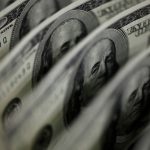
LONDON (Reuters) -The dollar was a touch lower on Monday as a soft U.S. jobs report boosted wagers that the Federal Reserve may still cut rates this year, while the yen lurched lower after last week’s suspected intervention fuelled a wild ride.
The yen last week clocked its strongest weekly gain since early December 2022 following two bouts of suspected intervention from Tokyo to pull the currency away from a 34-year low of 160.245 per dollar. It gained 3.5% in the week.
On Monday, the yen was lower, slipping 0.5% to 153.69 per dollar.
Japanese and British markets are both closed for a holiday on Monday, likely resulting in lower volumes, but with Japanese authorities choosing last week’s quiet periods to intervene in the currency market, traders will be on high alert through the day.
The more than 9 trillion yen that the Bank of Japan is estimated to have spent to prop up the frail yen last week has only bought it some time, analysts say, as the market still views the currency as a sell.
While Japan clearly has capacity to intervene more, the broader macro environment remains quite negative for the yen, according to Goldman Sachs strategists, noting intervention “success” can only go so far.
“But, buying time is still valuable, as it reduces the potential for economic disruptions from the exchange rate adjustment and could stabilise the currency until the economic backdrop becomes more supportive for JPY,” they said in a note.
The yen has been under pressure as U.S. interest rates have climbed and Japan’s have stayed near zero, driving cash out of yen and into higher-yielding assets.
The latest weekly report from U.S. regulators showed that non-commercial traders, a category that includes speculative trades and hedge funds, reduced their yen short positions to 168,388 futures contracts in the week ended April 30, still close to their largest bearish positions since 2007.
“In a week that’s light on U.S. data and heavy on Fed speeches, the Fed’s rhetoric post-payrolls will determine whether dollar-yen retests the 160-level anytime soon,” said Nicholas Chia, Asia macro strategist at Standard Chartered (OTC:SCBFF).
FED PATH
Data on Friday showed U.S. job growth slowed more than expected in April and the increase in annual wages fell below 4.0% for the first time in nearly three years, as signs of labour market cooling raised optimism that the U.S. central bank could engineer a “soft landing” for the economy.
Markets are now pricing in almost 50 basis points of cuts this year, with a rate cut in November fully priced in.
“It’s definitely what the Fed wants to see more of and the first report in quite a while that has surprised to the downside,” said Dane Cekov, senior FX strategist at Nordea.
The Fed held interest rates steady at the conclusion of its two-day monetary policy meeting last week, as expected, but signalled it was still leaning towards eventual rate cuts, even if they may take longer to come than initially expected.
“The weaker dollar trend started with the Fed and Powell when he essentially shut the door on further rate hikes,” Nordea’s Cekov said.
The dollar index, which measures the U.S. currency against six others, was at 105.10, having touched a more than three-week low of 104.52 on Friday. The index is up nearly 4% this year but fell almost 1% last week.
The euro last fetched $1.0764, while sterling was up 0.2% at $1.25715 before a Bank of England policy announcement on Thursday, where interest rates are expected to be held at 5.25%.
Mainland China’s markets opened after being closed for three days last week. In that time, the offshore yuan had risen on the back of the dollar’s broad retreat.
The offshore yuan eased to 7.2194 per dollar, having gained more than 1% last week. In the spot market, the onshore yuan opened at 7.2009 per dollar, its strongest since March 25. It was last at 7.2149. [CNY/]
To read the full article, Click Here

